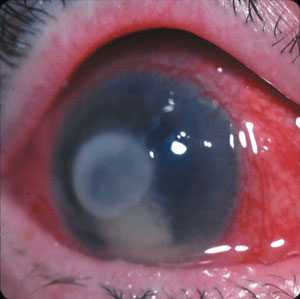 |
|
MRSA infections aren’t common, fortunately, but clinicians should be prepared for the rare occasions when they arise. Photo: J. James Thimons, OD. Click image to enlarge. |
Corneal crosslinking (CXL) is a relatively safe procedure, but it does have several rare complications, including delayed epithelial healing, stromal melting and scarring, progressive flattening and infectious keratitis. Of these, infectious keratitis is the most concerning complication, with a newly published case series suggesting that antibiotic-resistant bacteria are on the rise.
Researchers in Tokyo noted that when they first used CXL to treat keratoconus 13 years ago, they didn’t encounter a single case of infectious keratitis until 2016. In their most recent study, they reviewed cases from February 2007 through May 2020. During this time, 524 consecutive patients presenting with keratoconus underwent epi-off CXL using the Dresden protocol or an accelerated protocol under topical anesthesia and oxybuprocaine hydrochloride eye drops. Seven of these cases developed post-op infectious keratitis. The researchers reviewed these cases retrospectively.
“All cases appeared normal on the day after surgery, but subsequently developed eye pain, blurred vision, corneal infiltration, inflammation of the anterior chamber and ciliary injection on day two or three,” the researchers reported. They cultured methicillin-resistant Staphylococcus aureus from two eyes, methicillin-sensitive Staphylococcus aureus from two eyes and Streptococcus pneumoniae from one eye. Importantly, all detected bacteria were resistant to levofloxacin. “Five of the seven cases, especially four of the five severe cases with hypopyon, had a history of atopic dermatitis,” the researchers noted.
These seven cases all occurred within the past five years. “Post-CXL infections weren’t observed until 2016 in our institute,” the researchers said. “In the nine years from 2007 to 2015, we performed CXL on 141 eyes and experienced no case of infection. After the first case in 2016, the incidence increased to three of 134 eyes (2.2%) in 2019.”
Other reported causes of infectious keratitis after CXL have included gram-positive bacteria such as Staphylococcus epidermidis, Staphylococcus aureus, Streptococcus salivarius and/or Streptococcus oralis and gram-negative bacteria such as Escherichia coli, Pseudomonas aeruginosa, herpes virus, fungus and Acanthamoeba.
“Many microbes were resistant to the new quinolone antibiotics, similar to our findings,” the researchers said. “We used ofloxacin eye drops until 2000 and then levofloxacin eye drops since 2001 as preventive therapies after CXL, photorefractive keratectomy and phototherapeutic keratectomy. The new quinolone antibiotics, such as levofloxacin, gatifloxacin and moxifloxacin, have widely been used to prevent infection after various ophthalmological surgeries.”
They added that antibiotic resistance trends among ocular microorganisms are prevalent among staphylococcal isolates, but few changes were observed between 2009 and 2018 in the United States. In Japan, the prevalence of MRSA and methicillin-resistant, coagulase-negative staphylococci (MR-CNS) decreased significantly between 2005 and 2014, but more than 50% of Corynebacterium isolates remain resistant to levofloxacin.
“One study showed that the prevalence of levofloxacin-resistant MSSA increased significantly from 2008 to 2018, although the prevalence of MRSA didn’t increase,” the investigators noted. “MR-CNS wasn’t detected in 2008, thus microorganisms resistant to new quinolone antibiotics may have increased in recent years, raising the rate of postoperative infectious keratitis.”
From their case study, they noted that atopic dermatitis may increase the risk of post-CXL infection because levels of skin MRSA are elevated in these patients. “Patients on long-term steroids or immunosuppressants to treat allergic disorders such as vernal keratoconjunctivitis, bronchial asthma and eczema require special attention in terms of the evaluation of drug-resistant bacteria,” they wrote.
Because symptoms were apparent two to three days after CXL, the study authors recommend examining patients during this time period and initiating immediate microbiological testing, including for drug sensitivity. “We recently began to preoperatively screen for microbes via nasal culture,” they said. “The conjunctival sac is seldom culture-positive when patients don’t develop conjunctivitis. We also prescribe additional effective antibiotics, such as chloramphenicol, postoperatively, if some bacteria resistant to levofloxacin and/or other drugs were detected.”
Kato N, Ide T, Kobashi H, et al. Infectious keratitis after corneal crosslinking for keratoconus caused by levofloxacin-resistant microorganisms. BMC Ophthalmol. 2021;21:317. |


